The Western Grebe, scientifically known as Aechmophorus occidentalis, is an elegant waterbird that inhabits the freshwater lakes and ponds of North America.
Renowned for its striking appearance, this species is characterized by its long neck, slender body, and distinctive black and white plumage.
With a preference for large inland bodies of water, Western Grebes engage in remarkable courtship displays, including synchronized swimming and elaborate head-bobbing rituals.
Their exceptional swimming abilities are enhanced by lobed toes and a streamlined build, making them adept hunters of fish and aquatic invertebrates.
These social birds are often found in colonies, displaying intricate communication through a variety of vocalizations.
The Western Grebe not only contributes to the ecological balance of its habitat but also captivates observers with its graceful movements and intricate behaviors, embodying the beauty and biodiversity of North American aquatic ecosystems.
Physical Characteristics of Western Grebe
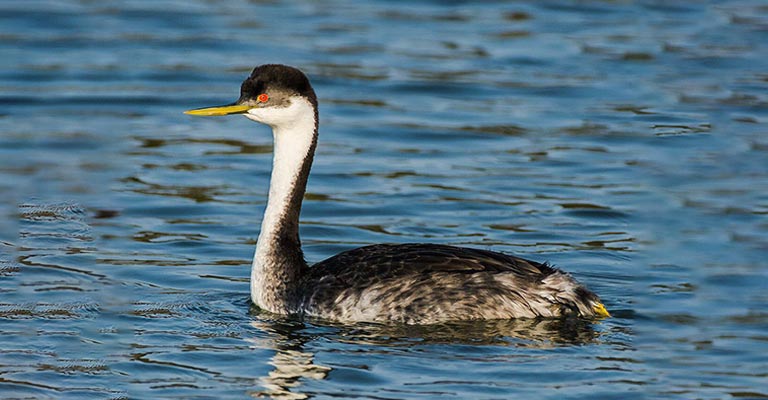
The Western Grebe, Aechmophorus occidentalis, boasts distinctive physical characteristics that make it easily identifiable in its natural habitat.
Observers can discern this elegant waterbird through a combination of unique features that contribute to its striking appearance and adaptability for life in freshwater environments.
Size and Shape
The Western Grebe is a sizable bird, measuring between 22 to 29 inches in length, with a wingspan ranging from 24 to 31 inches.
Its slender, elongated body and long neck contribute to its graceful silhouette, while its pointed bill enhances its streamlined profile. These proportions distinguish it from other waterfowl in its habitat.
Plumage
The most distinctive aspect of the Western Grebe’s appearance is its striking black and white plumage.
During the breeding season, adults exhibit a sleek black neck and head, contrasting sharply with the white plumage covering the rest of their bodies. Outside of the breeding season, the black plumage recedes, leaving behind a more subdued and mottled appearance.
Red Eyes
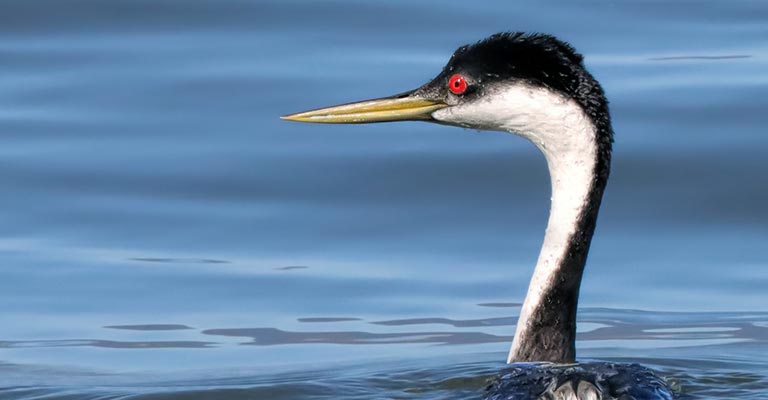
The Western Grebe is characterized by its striking red eyes, which add a vivid splash of color to its predominantly black-and-white visage.
These vibrant eyes are a key feature, standing out against the contrasting plumage and aiding in its visual communication.
Lobed Toes
Adapted for an aquatic lifestyle, the Western Grebe possesses lobed toes. This unique feature enhances its swimming abilities, providing greater propulsion in the water.
The lobes effectively act as paddles, allowing the bird to navigate lakes and ponds with exceptional agility.
Courtship Displays
During the breeding season, Western Grebes engage in elaborate courtship displays that involve synchronized swimming and head-bobbing rituals.
These behaviors are not only fascinating to witness but also serve as distinctive markers for identifying this species during its reproductive phase.
Social Behavior
Western Grebes are often found in colonies, and their social nature becomes evident through communal activities.
Observing a group of these birds engaging in coordinated movements on the water can be a key identifier, as their synchronized behaviors are a testament to their social bonds.
Distinctive Calls
The Western Grebe communicates through a variety of vocalizations, including soft whistles and grunting sounds. These calls serve as auditory cues, helping birdwatchers and researchers identify the species even when it is not immediately visible.
The Western Grebe’s identification relies on a combination of physical attributes, including size, plumage, eye color, and unique adaptations for an aquatic lifestyle.
Additionally, behavioral cues such as courtship displays and social interactions contribute to a comprehensive understanding of this remarkable waterbird in its natural habitat.
Taxonomical Details of Western Grebe
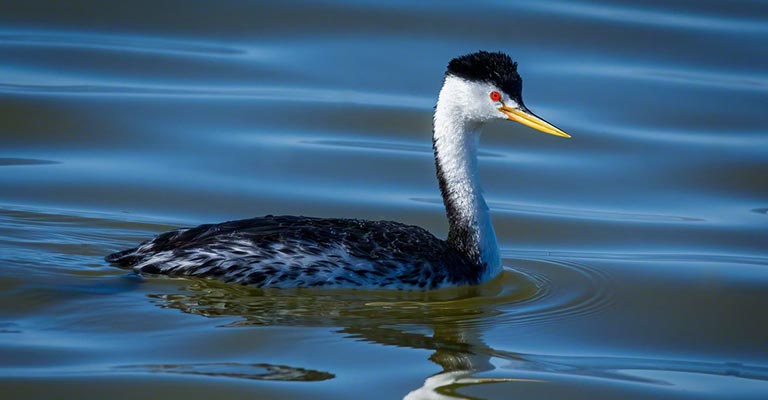
Here is a table showcasing the taxonomy details of the Western Grebe:
| Taxonomic Rank | Classification |
| Domain | Eukaryota |
| Kingdom | Animalia |
| Phylum | Chordata |
| Class | Aves |
| Order | Podicipediformes |
| Family | Podicipedidae |
| Genus | Aechmophorus |
| Species | A. occidentalis |
The Western Grebe (Aechmophorus occidentalis) encompasses several distinct subspecies, each with unique characteristics, ranging from size and morphology to geographic distribution.
These variations provide a nuanced understanding of the species’ adaptability across different regions.
A. occidentalis ssp. occidentalis (Lawrence, 1858)
This subspecies, found in western Canada and the United States (specifically California and Utah), is recognized for its large size and dark morph.
The deep, contrasting black and white plumage is a notable feature, especially during the breeding season. The overall size of this subspecies contributes to its striking and elegant appearance.
A. occidentalis ssp. ephemeralis, Dickerman, 1986
In contrast to the larger occidentalis subspecies, A. occidentalis ssp. ephemeralis hails from north and central Mexico. It is characterized by a smaller size and a dark morph.
The more diminutive stature distinguishes it from its counterparts in other regions. The dark plumage remains a consistent trait, providing a unifying visual element among the different subspecies.
A. clarkii ssp. clarkii (Lawrence, 1858) Dickerman, 1963
This subspecies, inhabiting north and central Mexico, stands out with its small size and pale morph. The lighter plumage sets it apart from the darker morphs found in other subspecies.
Despite its smaller size, the A. clarkii ssp. clarkii showcases the adaptability of the Western Grebe across diverse environments.
A. clarkii ssp. transitionalis, Dickerman, 1986
Residing in western Canada and the United States (specifically California and Utah), A. clarkii ssp. transitionalis is characterized by its large size and pale morph.
This subspecies exhibits a lighter coloration compared to the dark morphs, showcasing the variability within the Western Grebe population. The large size contributes to its overall presence in its habitat.
These subspecies collectively exemplify the adaptability and diversity of the Western Grebe across its range, from the expansive lakes of western Canada and the United States to the more southern regions of Mexico.
The variations in size, coloration, and morphology among these subspecies reflect the species’ ability to thrive in a range of freshwater environments and contribute to the rich tapestry of avian biodiversity in North America.
Food Habit of Western Grebe
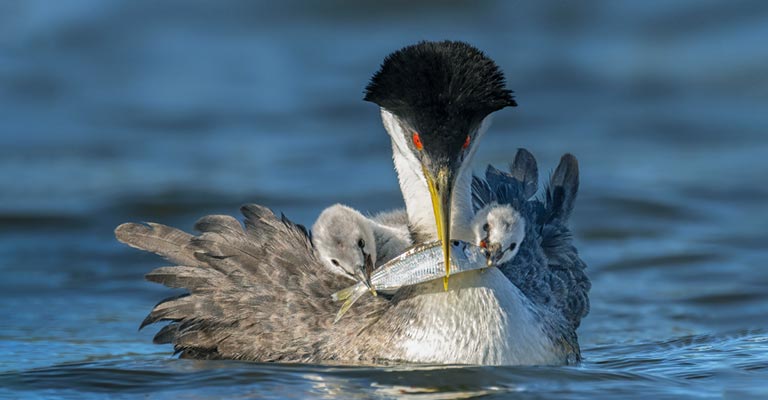
The Western Grebe (Aechmophorus occidentalis) is a proficient hunter with a diverse diet, primarily focused on aquatic prey. This species displays specialized feeding behaviors that align with its aquatic lifestyle, making it a skilled piscivore.
- Fish Predation: A primary component of the Western Grebe’s diet consists of various fish species, showcasing its adeptness in underwater hunting.
- Aquatic Invertebrates: In addition to fish, the grebe feeds on a variety of aquatic invertebrates, such as insects and crustaceans, supplementing its nutritional intake.
- Diet Diversity: The Western Grebe adapts its diet based on seasonal and environmental factors, demonstrating flexibility in prey selection.
- Diving Technique: Utilizing its streamlined body and lobed toes, the grebe employs a diving technique to pursue and capture prey beneath the water’s surface.
- Social Foraging: In some instances, Western Grebes engage in cooperative foraging, using group tactics to corral and capture schools of fish.
This diverse diet, coupled with specialized hunting techniques, underscores the Western Grebe’s role as a successful and adaptable predator in freshwater ecosystems.
Western Grebe Life History
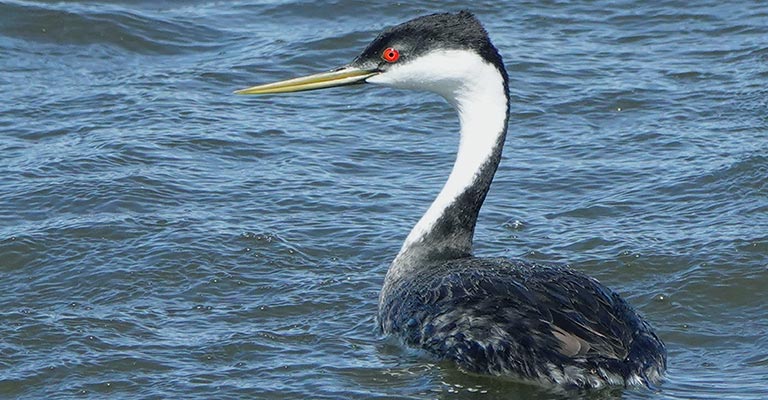
The Western Grebe (Aechmophorus occidentalis) is a captivating waterbird renowned for its striking appearance and intricate behaviors. Its life history encompasses various aspects, from reproduction to conservation efforts.
Understanding the intricacies of the Western Grebe’s life history sheds light on its role in aquatic ecosystems and highlights conservation challenges.
Reproduction
During the breeding season, Western Grebes engage in elaborate courtship displays, including synchronized swimming and head-bobbing rituals. Colonies often form, and both parents contribute to nest building and incubation.
The young, adorned with distinct striped patterns, are proficient swimmers shortly after hatching, emphasizing the species’ commitment to reproductive success.
Habitation
Western Grebes favor large inland bodies of water, such as lakes and ponds. Their habitat choice aligns with their piscivorous nature, providing an abundant source of fish and aquatic invertebrates.
Nesting occurs in colonies, fostering social interactions and cooperative behaviors.
Range Map
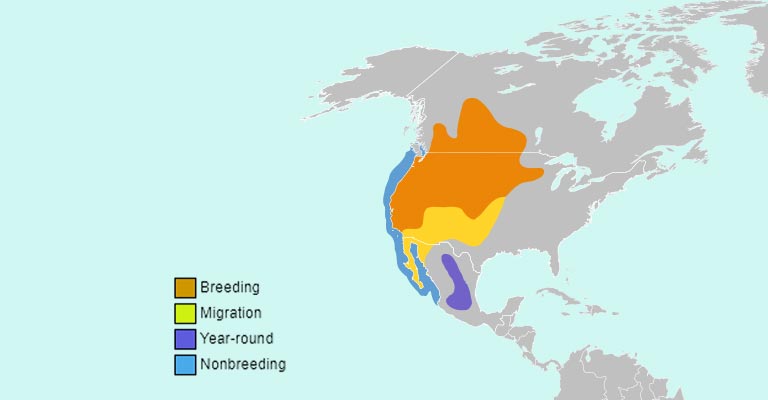
The Western Grebe’s range spans across North America, with subspecies occupying specific regions.
A comprehensive range map reveals their presence from western Canada and the United States to north and central Mexico. This distribution underscores the adaptability of the species to diverse environments.
Diseases
Western Grebes may face health challenges, including avian botulism, which can affect waterbirds in their habitats. This neuromuscular disease poses threats to populations, impacting their ability to forage and reproduce.
Treatment
Efforts to address avian botulism involve rehabilitation centers and wildlife organizations. Treatment may include supportive care, nutritional interventions, and, in severe cases, antitoxin administration.
Collaboration among researchers, veterinarians, and conservationists is crucial for effective disease management.
Conservation
Conserving Western Grebe populations requires a multifaceted approach. Habitat preservation, water quality management, and sustainable fishing practices contribute to their well-being.
Monitoring and addressing threats like habitat loss, pollution, and climate change are pivotal for the species’ long-term survival.
The life history of the Western Grebe encompasses reproductive strategies, habitat preferences, geographic distribution, health considerations, and conservation measures.
This comprehensive understanding not only enriches our appreciation for this remarkable waterbird but also guides conservation efforts to ensure its continued presence in North American ecosystems.
Nesting Habit of Western Grebe
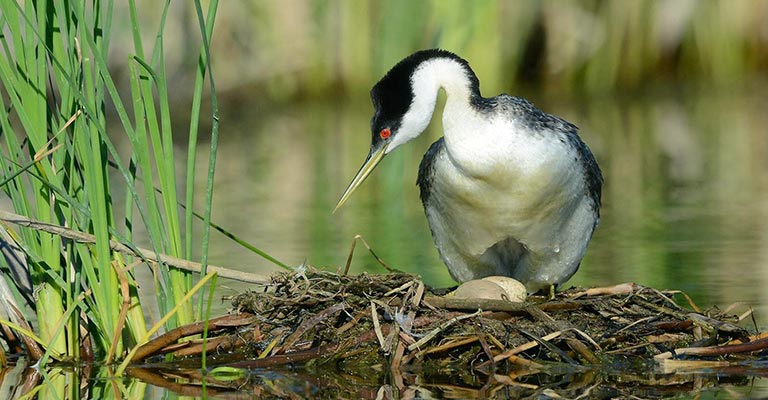
The nesting habits of the Western Grebe are characterized by a clutch size of 3 to 7 eggs, typically yielding one brood per breeding season.
The slightly elongated eggs, around 2.4 inches in length and 1.5 inches in width, are incubated for approximately 23 to 24 days.
Nesting sites consist of floating platforms made of vegetation, with colonies forming during breeding. Both parents actively participate in nest-building and care, alternating shifts during incubation.
The nestlings are fed a diet of fish and aquatic invertebrates, and protective measures, such as distraction displays, are employed to mitigate predation risks, enhancing the species’ reproductive success.
Here’s a table summarizing the nesting details of the Western Grebe:
| Nesting Details | Information |
| Clutch Size | 3 to 7 eggs |
| Number of Broods | Typically one brood per breeding season |
| Egg Length | Approximately 2.4 inches (6 cm) |
| Egg Width | About 1.5 inches (3.8 cm) |
| Incubation Period | Around 23 to 24 days |
| Nestling Period | About 10 to 12 weeks |
| Egg Description | Slightly elongated, pointed at one end |
| Nesting Site | Floating nest platform made of vegetation |
| Parental Involvement | Both parents contribute to nest building and care |
| Nesting Habits | Colonies often form during the breeding season, with nests positioned near one another |
Behavioral Habit of Western Grebe
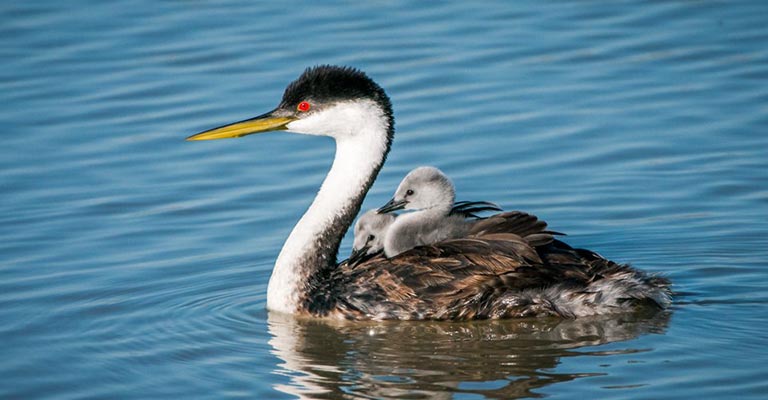
The Western Grebe (Aechmophorus occidentalis) exhibits a fascinating array of behavioral habits that contribute to its adaptability and survival in freshwater ecosystems.
From elaborate courtship rituals to cooperative foraging, these behaviors reflect the species’ social nature and specialized adaptations.
Courtship Displays
One of the most captivating aspects of Western Grebe behavior is their elaborate courtship displays, particularly during the breeding season.
Synchronized swimming, head-bobbing, and vocalizations create a mesmerizing spectacle that reinforces pair bonds.
Cooperative Foraging
Western Grebes often engage in cooperative foraging, utilizing group tactics to corral and capture schools of fish.
This social behavior not only enhances their hunting efficiency but also underscores the advantages of collaboration in acquiring food resources.
Diving Expertise
With their streamlined bodies and lobed toes, Western Grebes are adept divers. Their diving expertise allows them to pursue prey beneath the water’s surface, showcasing their specialized adaptations for an aquatic lifestyle.
Social Structures
Colonies of Western Grebes form during the breeding season, emphasizing their social nature.
These structures provide not only communal protection but also opportunities for synchronized behaviors and communication through various vocalizations.
Parental Care
Both parents actively contribute to nest-building, incubation, and feeding of nestlings. Their shared parental responsibilities highlight a cooperative approach to ensuring the well-being and survival of their offspring.
Distraction Displays
To protect nests from predators, Western Grebes employ distraction displays. This may involve feigned injuries or dives to divert attention away from the vulnerable nesting site, showcasing their strategic and protective instincts.
Agile Swimmers
Western Grebes are known for their exceptional swimming abilities. Their agile movements on the water, coupled with lobed toes for efficient propulsion, make them formidable hunters, navigating lakes and ponds with grace.
The behavioral habits of the Western Grebe encompass a spectrum of social, reproductive, and foraging strategies.
These behaviors not only enhance their survival in diverse habitats but also contribute to the intricate tapestry of avian life in North American freshwater ecosystems.
Wrapping Up
The Western Grebe, with its captivating behaviors, adaptive strategies, and vital ecological role, stands as a testament to the intricate balance of nature in North American freshwater habitats.
From synchronized courtship displays and cooperative foraging to protective parenting measures, this waterbird showcases the beauty of avian life. Their streamlined bodies, distinctive plumage, and social structures contribute to the rich tapestry of biodiversity.
The Western Grebe’s nesting and feeding habits, combined with its agile swimming skills, emphasize the species’ specialized adaptations for life on the water.
As conservation efforts continue, understanding the comprehensive life history and behaviors of the Western Grebe becomes paramount in ensuring the long-term survival of this remarkable species and the preservation of the ecosystems it calls home.